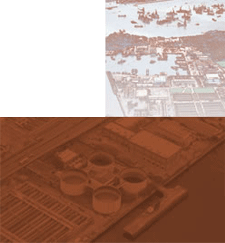
|
Overview
All urban areas of Hong Kong and 95% of the households are connected
to the public sewerage system. The quantity of sewage treated amounts
to 2.5 million cubic metres a day. Our job is two-fold. Firstly,
we must ensure that the existing sewerage network and sewage treatment
facilities are operated and maintained properly and efficiently
such that sewage is collected, treated and disposed of
|
safely to the required standard. Secondly,
we need to upgrade the existing sewerage infrastructure and build
new facilities to serve the territory's continual development
and to satisfy the community's demand for a higher standard
of environmental protection.
On sewerage infrastructure, our plans include the Harbour Area Treatment
Scheme (HATS) which focuses on the collection and treatment of sewage
generated from both sides of Victoria Harbour, and the other involves
meeting demands and improvement as identified by 16 Sewerage Master
Plan (SMP) covering the rest of the territory.
HATS Stage I was commissioned in 2001. The centralized sewage treatment
plant at Stonecutters Island treats 1.4 million cubic meters of sewage
per day, bringing substantial improvement to water quality in the
Victoria Harbour area.
In order to further improve the water quality in Victoria Harbour,
studies and pilot trials were conducted in 2003/04. Plans are proposed
to collect sewage generated in the north and northwestern parts of
Hong Kong to the Stonecutters Island Sewage Treatment Works for proper
treatment before discharge to the sea. Public consultation is to be
launched in the latter part of 2004.
Apart from Victoria Harbour, other major environmental improvement
facilities include the commissioning of the CEPT plant at Sham Tseng
in end 2003. Construction of the first tertiary sewage treatment plant
with effluent reuse at Ngon Ping, Lantau Island also represents a
major milestone in treatment advancement in Hong Kong. Due to its
close proximity to environmentally sensitive areas, very stringent
discharge requirements apply. Tertiary treatment has therefore been
adopted in the design. Construction started in 2003 for completion
in 2005.
Prevention
against SARS Infection in the Operation of
Sewage Treatment Facilities during 2003 Outbreak |
|
On 26 February 2003, there were reports on the first case of a flu-type
virus Atypical Pneumonia, now commonly known as Severe Acute Respiratory
Syndrome (SARS), in Hong Kong. Thereafter, the disease spread quickly
and more and more people were infected. In response to the outbreak,
DSD
issued a circular memorandum on 25 March 2003 to provide guidelines
to the staff, particularly those working in sewage treatment facilities,
for prevention of the disease.
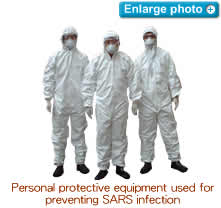 |
Shortly after the issue of the circular,
individual Divisions also drew up specific guidelines for their
staff to prevent against SARS infection. In the guidelines for
operating sewage treatment facilities, all plant staff were
reminded to maintain personal hygiene, wear suitable personal
protective equipment when working in areas having high risk
of contact with sewage or sewage-contaminated equipment. These
guidelines were updated regularly in subsequent months. In addition,
professional advices were sought from the Labour Department
and the Departmental Safety Advisory Unit. Officers from the
Labour Department and the Safety Advisory Unit had also made
on-site inspections and offered suggestions on the safety and
hygiene procedures for staff working in sewage treatment works. |
In addition to the hygiene and safety guidelines, it was essential
to make available sufficient suitable personal protective equipment
for staff working in sewage treatment facilities. Adequate stocks
of these equipment including various types of masks, goggles, protective
clothes were maintained during the period of the SARS outbreak.
On 19 April 2003, a territory-wide Cleaning Day campaign was held
to step up the cleansing and disinfection in the territory. On that
day, we carefully monitored the operation of all sewage treatment
facilities to ensure no adverse effect would be caused by the large
amount of cleansing and disinfection agent flowing into the plants.
The fight against SARS had never been stopped even after the critical
period of the SARS outbreak. Continuous effort has been put in the
prevention of the SARS infection and a Contingency Plan has been compiled
for use just in case the disease attacks Hong Kong again.
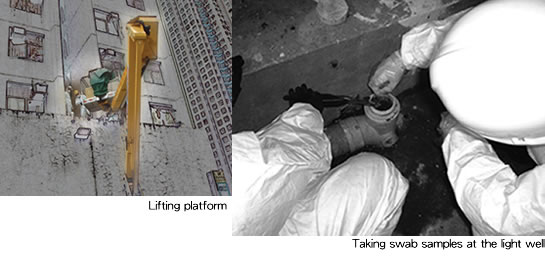
Swab Sampling
in Sewage Discharge Pipe
at Amoy Garden |
|
DSD participated in the investigation of environmental factors contributing
to the outbreak of SARS in April 2003 among occupants in Block E of
Amoy Garden. The main task for the Department was to conduct swab
sampling at sewage discharge pipe for the examination of E Coli, an
indicator of faecal contamination in water. The sampling exercise
was conducted in two phases with the first phase concentrated in collecting
samples from sewage discharge pipe from Block E, shortly after the
building was cleaned and disinfected. The second phase included conducting
similar sampling at nine other buildings of Amoy Garden.
The laboratory of Sewage Treatment Division 1 was assigned for the
sampling duty. The sampling team consisted of a Chemist and two Engineering
Laboratory Technicians. It was assisted by staff of the Mainland South
Division who conducted a pipe work survey prior to sample collection.
They were also responsible for making arrangements with other government
departments and hire of contractors for the provision of lifting platform.
Personal protective gears were provided to DSD's team by the
Department of Health, and clean-up and disinfection were carried out
on site after the sampling exercise.
Swab sampling was conducted in the light well of each block where
discharge pipes from washbasin, bathtub, floor drain, and toilet bowls
were opened for sample collection. More than 100 samples were collected,
covering most of the targets in the sampling scheme. Some difficulties
were encountered including temporary suspension of sample collection
when sewage discharge was detected. Other difficulties also included
opening of blocked inspection windows and answering calls in a whole
set of protective gears. The DSD sampling team successfully accomplished
the assignment on time, demonstrating our professionalism and commitment
in combating SARS in Hong Kong.
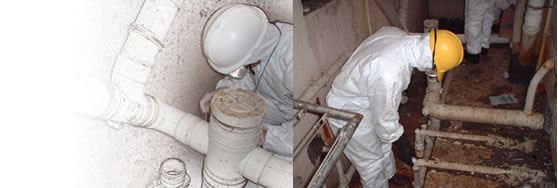

The First Tertiary Treatment Plant with Effluent Reuse-
Ngong Ping Sewage Treatment Works (STW)
Ngong Ping is an environmentally sensitive area as it is located within
the water gathering ground for Shek Pik Reservoir and surrounded by
country parks. The Ngong Ping STW are designed to meet the sewage
treatment and disposal needs of Ngong Ping and its surrounding area
arising from the anticipated substantial increase in tourists upon
the opening of the Cable Car System and associated tourist developments
in Ngong Ping in late 2005.
In order to protect the water quality of the water gathering ground
and other receiving water bodies, the sewage collected in Ngong Ping
will be treated to tertiary level before discharge. The Ngong Ping
STW is the first tertiary sewage treatment plant in Hong Kong. This
plant will adopt the technologies of Sequencing Batch Reactor (SBR),
dual media filter and disinfection process to reduce organic pollutants,
suspended solids, nutrients and pathogenic organisms in sewage to
a very low level.
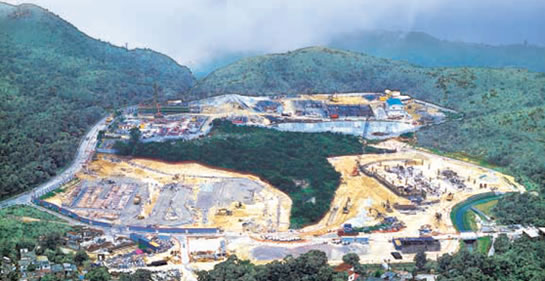
The high quality of the treated effluent from the Ngong Ping STW provides
a good opportunity for conducting a pilot scheme on effluent reuse.
Under this scheme, the treated effluent from the sewage treatment
plant will be used for flushing in the public toilets in Ngong Ping,
the cable car terminal and associated tourist facilities. The scheme
will provide information and useful experience for the Government
to further assess the technical, administrative, cost-effectiveness
and other considerations for wider use of treated effluent in the
territory.
An Environmental Impact Assessment (EIA) study has been conducted
for the project. The EIA study, approved by the Director of Environmental
Protection, has indicated that the environmental impacts are within
acceptable standards.
Sham Tseng
Sewage Treatment Works (STW) -
benefiting residents in the area |
|
The Sham Tseng STW was commissioned in December 2003. It has a capacity
to treat 16,500 m3 of sewage per day, adequate to serve
a population of about 55,000 in the Tsing Lung Tau, Sham Tseng and
Ting Kau areas.
The Sham Tseng STW adopts a chemically enhanced sedimentation plus
ultraviolet disinfection process for treating sewage. Construction
of the plant commenced in May 2001. The contract sum is about HK$345M.
This plant uses liquid alum as coagulant and polymer to enhance the
floc formation and settling. These chemicals are added proportional
to the incoming flow at the optimum rates. This is achieved with a
fully automated Integrated Control System.
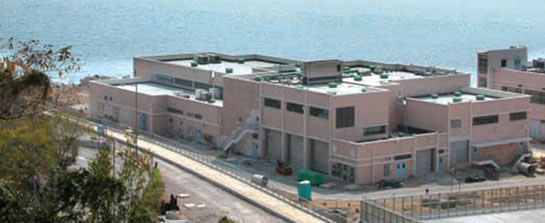
Connection of sewers from individual residential developments and
village houses in Sham Tseng to the STW for treatment are being progressively
carried out. Besides, the works for extending the public sewerage
system eastwards to Ting Kau and westwards to Tsing Lung Tau are under
construction. Upon completion of these works in the coming years,
sewage generated from Ting Kau, Sham Tseng and Tsing Lung Tau will
all be collected to Sham Tseng STW for treatment and disposal. Commissioning
of Sham Tseng STW will not only benefit the public with the high quality
sewage treatment service, it will also help resolve the water pollution
problem in the unsewered areas, thus improving the living environment
of Ting Kau, Sham Tseng and Tsing Lung Tau and the water quality in
local beaches.
| Odour Abatement
in Shatin Sewage Treatment Works |
|

Malodourous complaints on Shatin Sewage Treatment Works had increased
sharply in early 2003. Nearly 90% of these complaints were received
between April and July 2003. Noting the drastic increase in odour
complaints, DSD responded promptly with some improvement measures
to immediately alleviate the odour impacts to the nearby sensitive
receivers. From record, there was no odour complaint received from
September 2003 to March 2004.
All odour control measures are derived from the principles of:
 |
Source control; |
 |
Containment; and |
 |
Treatment. |
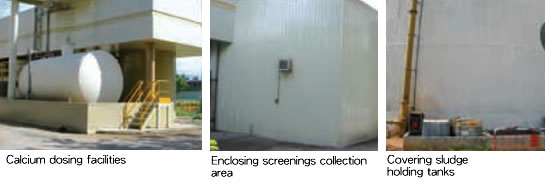 In controlling
the formation and emission of odour, mainly hydrogen sulphide, calcium
nitrate was added to the incoming sewage at the inlet works as an
interim measure. More effective long-term calcium nitrate dosing facilities
at the pumping stations would be commissioned in 2004. Dosing of ferric
chloride to reduce generation of hydrogen sulphide in the sludge treatment
process has been practised for some years and the method has been
proved to be effective. More dosing points were added last year to
further suppress the release of hydrogen sulphide. In controlling
the formation and emission of odour, mainly hydrogen sulphide, calcium
nitrate was added to the incoming sewage at the inlet works as an
interim measure. More effective long-term calcium nitrate dosing facilities
at the pumping stations would be commissioned in 2004. Dosing of ferric
chloride to reduce generation of hydrogen sulphide in the sludge treatment
process has been practised for some years and the method has been
proved to be effective. More dosing points were added last year to
further suppress the release of hydrogen sulphide.
Efficient desludging at primary sedimentation tanks can help reduce
generation of hydrogen sulphide from the settled sludge during its
retention in the tanks. A modern type of continuously operated sludge
scraper was used to replace most of the old, aged and less efficient
travelling bridge scrapers in 2003-04.
The second step is to enclose the odour sources, such as flow channels,
water chambers and screenings collection areas, that was completed
in 2003. Deodouriser was installed to these enclosures to remove malodourous
gases. Low cost high odour removal efficiency biofilter was used for
deodourisation.
Regular monitoring of hydrogen sulphide level at ten strategic locations
of the works commenced in July 2003. Monitoring results indicated
that the hydrogen sulphide concentration had dropped and been maintained
at very low levels since the last quarter of 2003. This finding is
also in line with the odour complaints received. During an interview
with a resident in the nearby Kam Tai Court on 19 June 2004, the resident
greatly appreciated DSD's efforts in odour abatement and remarked
that the odour level had significantly reduced in the past twelve
months.
| Environmental
Performance Target |
|
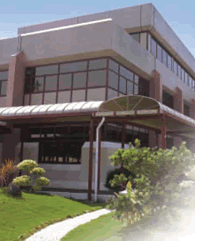 |
The effect on the environment by a sewage treatment
plant is best measured by the quality of effluent it produces.
The effluent quality is regulated by the Discharge License Conditions
(DLC) of the Discharge License whereby limitations and standards
are set by the Environmental Protection Department for a number
of parameters including the total suspended solids (TSS), the
5-day biochemical oxygen demand (BOD5), ammonia nitrogen, total
nitrogen and the E. Coli count for indicating the amount of
faecal bacterial population in the treated effluent.
In 2003-04, a compliance record of 98% was achieved arising
from 6,297 tests conducted in all DSD operated plants. The environmental
performance target for DSD-operated sewage treatment plants
in 2004-05 is to achieve a compliance percentage of 95% in all
samples tested under the self-monitoring scheme specified in
the DLC. This is also the performance target in the design for
most sewage treatment |
plants in the Department and the result should reflect the effort
of the operator and the level of treatment achieved.
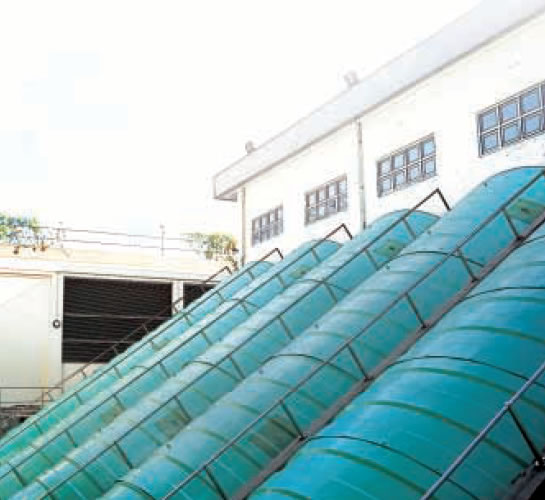
Difficulties in laying
sewers in busy urban streets-
the traffic diversion perspective |
|
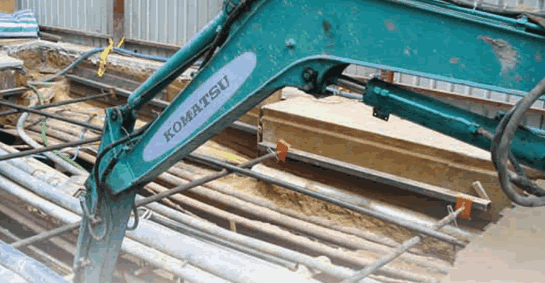
Laying new sewers is never an
easy task as roads in Hong Kong are congested with different kinds
of public utilities. Though new technological development in trenchless
construction method over the last 10 years or so has relieved the
situation to a great extent, laying of sewers still unavoidably requires
partial or even complete closure of roads for a few months or longer,
and therefore causing adverse impact on the traffic particularly in
busy urban streets. Closure of roads, particularly in front of shops,
will never be welcome by the public and the shop owners. Laying sewers
in busy urban streets therefore remains a great challenge to the Department.
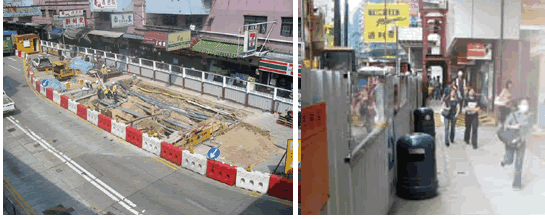
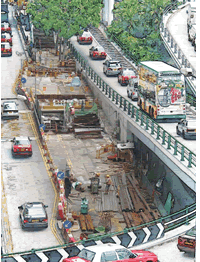 |
In order to improve the co-ordination and control
of road opening works and to reduce traffic impact, all major
sewers laying projects are subject to traffic impact assessments
during the design stage. Consultation with affected shop owners
and residents will also be carried out. During the construction
stage, all proposed works have to be discussed at Traffic Management
Liaison Group with members from Police, Transport Department,
Highways Department, and other stakeholders, and the proposed
temporary traffic management measures and diversion schemes
will be subject to trial run before the works are commenced.
Consultation with concerned shop owners will be carried out
again to solicit their views on the types of hoarding and other
relief measures according to the prevailing site operation and
condition. Appropriate conditions, such as restriction on working
hours, minimum footpath width etc, would be specified in order
to minimise the disturbance.
|
The Department always adopts a proactive public communication approach
to obtain the public support for the works. Innovative design, such
as fully transparent hoardings, will be adopted to enhance the construction
environment. Clear and sufficient signage will be put up for both
drivers and pedestrians. |
 |

